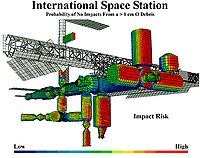
Photo from wikipedia
There is inadequate herd and community level information on the impact of CBPP and its control by vaccination to allow adequate allocation of resources for CBPP control in affected ecosystems.… Click to show full abstract
There is inadequate herd and community level information on the impact of CBPP and its control by vaccination to allow adequate allocation of resources for CBPP control in affected ecosystems. A study was designed in Narok district of Kenya provide this crucial information for the Maasai ecosystem. Data were collected through a cross-sectional survey involving 232 households, a longitudinal survey involving 39 herds, 32 outbreak investigations and a project vaccination follow up involving 203 households. Data were also collected from secondary sources and from current and past vaccination programs. Deterministic spreadsheet models estimated the cost of vaccination at KSh 34.6 (USD 0.49) to KSh 72.2 (USD 1.03): 1USD=KSh 70 per animal depending on the vaccination program. The value of annual production losses due to CBPP in the district were estimated at KSh 113.1 million (USD 1.62 million). The estimate of annual losses associated with response to outbreaks amounted to KSh 12.8 million (USD 0.18 million). Disease reporting and treatment of the sick accounted for 34.7% and 48.4% of the estimated value of annual losses associated with response to outbreaks respectively. Annual household CBPP losses were estimated at KSh 275.3 thousand (USD 3933), over twice the average annual household net income of KSh 118.8 thousand (USD 1697) from cattle. At community level, the estimated annual cost of preventive CBPP vaccination through a Wellcome Trust project was KSh 8.53 million (USD 0.12 million), 35.2% of which was due to indirect costs following adverse reactions to vaccination. A benefit-cost analysis demonstrated the annual net benefits to be KSh 67.8 million (USD 0.97 million) and BCR to be 9.60. Herd level BCR was 12.81 while annual net benefits were KSh 35.5 thousand (USD 507.81). Sensitivity analysis showed that vaccination was economically beneficial even when costs of vaccination nearly doubled in biannual vaccination. A break even analysis showed that the threshold herd incidence below which vaccination ceases to be economically worthwhile was 1.1% and 2.3% in annual and biannual vaccination respectively. In conclusion, a CBPP outbreak could cause the loss of a household's entire income from cattle keeping. The highest proportion of costs associated with response to outbreaks was in reporting and treatment of the sick. Early reaction to CBPP reports and eventual eradication of CBPP in the community is therefore urgent to safeguard livelihoods. Annual and biannual CBPP vaccination by any of the programs studied would be beneficial even if the incidence of the disease were as low as 2.2% and 3.9% respectively. However, losses due to adverse post-vaccination reactions need to be monitored and adequately managed. Macroeconomic analysis of the impact of CBPP and its control along the value chain is recommended for better decision making regarding CBPP control at national level.
Journal Title: Livestock Science
Year Published: 2017
Link to full text (if available)
Share on Social Media: Sign Up to like & get
recommendations!